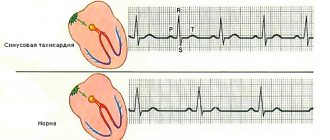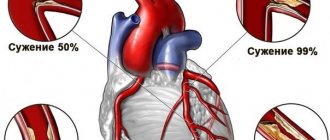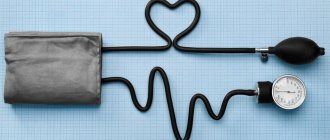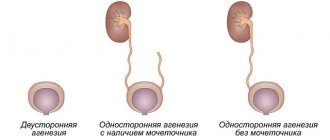Heart rate during sleep decreases by an average of 7-8% in adults and 8-9% in children compared to daytime values (at rest). The lowest heart rate occurs around 4 a.m., and the pulse accelerates before waking up. To measure, you need the help of a loved one; he counts the pulsation on the wrist, but this method is very inaccurate.
A fitness bracelet can also help determine your nighttime heart rate; some models have a data saving function. To diagnose heart disease, it is necessary to register an ECG in the 24-hour monitoring mode; only with its help are rhythm disturbances and vascular diseases detected. By the indicator of heart rate variability (variability) at night, you can predict the risk of stroke, heart attack, and heart failure.
What affects a sleeper's heart rate?
Pulse is one of the types of biomarkers, relying on its indicators to determine the general condition of the human body. At the time of sleep, jerky oscillations in the artery decrease, the functions of the cardiovascular system slow down, and metabolic processes weaken. Cells require less oxygen.
This process regulates the activity between organs, some are stimulated, others, on the contrary, arrive in complete relaxation. Heart rate and intensity are affected by:
- gender identity;
- age;
- physical state.
The more trained a person is, the lower the heart rate reduction. For men, the difference is considered to be in the range of minus 5-10 beats. In children, compared to the older generation, pulsation increases by 25-30 beats/minute.
Causes of a rare pulse (bradycardia) in children
A heart rate significantly lower than normal may indicate the development of a number of pathological conditions:
- Electrolyte disturbances.
- Some infectious diseases.
- Hypofunction of the thyroid gland.
- Autonomic disorders.
- Congenital heart defects.
- Myocarditis.
- Poisoning with toxic substances (nicotine, lead, drugs, etc.).
- Brain lesions, etc.
Thus, the pulse can serve as an important diagnostic marker for various diseases. Therefore, during each examination of small patients, the pediatrician evaluates this physiological parameter. Of course, it is impossible to determine what is happening to a person, what caused bradycardia or tachycardia (some kind of illness or banal excitement and fear of a white coat) only by heart rate. This requires other data - the results of examination, instrumental and laboratory studies.
Reasons for changing frequency
Changes in heart rate are provoked by certain physiological conditions:
- drinking alcohol, coffee drinks, certain medications;
- hard physical labor and training in sports complexes;
- emotional impulses (experience, fear, fright, joy, stress).
A hot climate changes body temperature and causes an increased heart rate. At night, biorhythms slow down by 1.5 times, and at 4 am the lowest parameters are observed. This is due to the functioning of the vagus nerve, which suppresses the functioning of the cardiovascular system. The pulse during sleep in an adult can reach up to 30 beats/minute. Most often, the risk of a heart attack occurs between 4 and 6 hours.
Important! It is necessary to pay attention to the number of beats per minute on the left and right hands; if they differ, it means that blood circulation in the limbs is impaired.
The body gradually enters a state of rest, the brain sends signals about the upcoming rest. Before going to bed, the pulse ranges from 55-60 beats/minute, but this is if the person falling asleep is in a non-irritated state and does not have heart disease. Complete peace occurs in the first phase of the dream and in the early morning, the frequency of pulse vibrations is low.
Heart rate slows down slightly before bed
Prevention
In order to get the proper heart rate, you need to follow the recommendations for preventing its increase. Regardless of age, it is recommended that a person go to bed so that he spends at least 8 hours sleeping. If life has a busy pace, it is important to find time to relax during the day.
To eliminate problems when there is an increased heart rate in the morning, it is necessary to establish the root cause of this deviation. You cannot attempt to normalize your readings on your own, since along with your pulse, your blood pressure can also drop, which will negatively affect your health. Seeing a doctor should be mandatory. To maintain indicators at the level of the individual norm, you will need to do gymnastics, perform certain physical activity, and eat right. It is important to remember that when falling asleep, the pulse quickens if a person is nervous; accordingly, you need to avoid stressful situations and take measures to rid the body of the stress on the nervous system. During prolonged physical and other activities, you should rest for at least 20 minutes, every 3-4 hours. We must remember that the price of correct actions is health.
If necessary, you need to follow a diet to reduce the load on the blood vessels and heart, and give up alcohol and smoking. It is recommended to additionally take multivitamins, which contain components valuable for the heart and blood vessels - potassium and magnesium.
Thus, the normal pulse rate during sleep in children or adults is an individual indicator, but deviations are possible that indicate some health problems. Timely measurements will help determine the moment when the number of impacts began to exceed. To stabilize the condition, medical consultation and prevention are required. Medical devices for measuring pulse are presented in the Promsnab catalog; they will allow you to not make a mistake in the number of beats.
Normal for an adult during sleep
Wakefulness is a stage of life with high activity of organs, tissues, and cells. Everything is in a running mechanism, the pulse is actively beating. Rest and dreaming are the opposite of wakefulness, which implies a weakening of all sources of energy in the body.
The process of slowing down arterial impulses begins to be observed at the moment a person is sent to the kingdom of Morpheus. Studies by medical scientists have found that during wakefulness the pulse should be 8-10% stronger than at rest. However, everything depends on other factors: age, gender, psychological and physical aspects.
No ads 2
Impact on heart rate of sleep phases
Human behavior during the day has several phases that replace each other and thereby affect the pulse. At night the same thing happens, depending on the sleep phase (there are 5 in total), the pulse changes. The intensity varies from highest to lowest, and vice versa.
In the first four phases of the dream, gradual relaxation and deepening of sleep occurs. The heart muscle begins to contract more slowly, and the pulse also slows down. This is the majority of normal sleep, approximately 80%.
Fifth stage of sleep
The phase is a parameter of REM sleep, when a person dreams, at this time physiological processes change. In particular, an emotional reaction occurs that provokes cardiac impulses with an increase in the frequency of beats per minute. It is even possible to exceed normal levels of wakefulness.
Also in this phase, other physiological processes can be launched:
- increased breathing;
- sweating;
- body movement.
This also provokes an increase in pulse impulses. If you are not dreaming or the person is dreaming with pictures of a calm genre, the pulse will be stable throughout the night, without fluctuations. If we talk about the ideal pulse, then 70 beats/minute is the most favorable indicator that confirms the normal heart rate of a healthy person.
Israeli scientists believe that a decrease in heart rate during sleep increases the risk of death several times. Their verdict is that you can live with this frequency of contractions for only 7 years.
Numerous studies prove that people with extra pounds, obesity, diabetes, and hypertension are susceptible to slowing down their heart rate.
Pulse: normal, dangerous indicators:
In the body of a healthy person, everything should work like a clock. But sometimes there are situations when, for one reason or another, something does not function correctly. In this article I would like to talk about what a pulse is. The norm and indicators dangerous to humans will be discussed in detail. Lack of proper attention to the existing problem can lead to the most serious consequences.
What it is?
First of all, you need to understand the concept itself. So what is pulse? In simple words, these are blood fluctuations that are caused by the work of the human heart. A push or beat is all contractions of the cardiac ventricle. In order to feel the pulse, it is enough to place your finger on the place on the body where the arteries are located close to the skin. In most cases, this is the area around the wrist or on the neck.
Age differences
It is worth saying that the pulse will be completely different for different age groups. The norm for an infant, a teenager and a healthy adult are different indicators. So, for a baby this is 140-180 beats per minute. For a one-year-old baby, 110-115 beats are considered normal. During adolescence, these numbers become different. For a child 14-15 years old, the normal pulse is 80-85 beats per minute. As a person gets older, the heart rate will gradually decrease. It may be interesting to note that in old age the heart rate will rise again, but normally it should not be higher than 80 beats per minute. It is worth saying that the pulse rate in men is slightly lower than in women. The difference is ten strokes. Also, the pulse will be calmer, by about 10-20 beats, during sleep. As a small conclusion, I would like to say that the lower the pulse, i.e. The fewer the number of strokes, the better for the person. This means that the heart copes with various loads without any problems and is not overworked.
Pulse detection
Knowing what the pulse should be (normal), you need to be able to determine it correctly. After all, it is not enough to know the places where it can be felt; it is also important to carry out all the manipulations in the special condition of the human body. So, what should you consider if you want to feel your pulse? The first option: contact your doctor or family doctor for help. This most often takes a lot of time and effort, but the result will be 100% correct. You can try to do everything yourself using special electronic means (even blood pressure monitors measure your pulse), the numbers will also be as accurate as possible. But the easiest way is to use the method of traditional medicine. What do you need to know for this? First: throughout the day, a person’s pulse constantly changes depending on what activity he is engaged in. It is lowest in the morning and evening. The best option is to measure your heart rate in the morning. To get correct results, you need to listen to the beats for either half a minute (the error will most likely be minimal) or a full minute. It is also more correct to calculate your pulse from 11 to 13 hours of the day, since the body is in a calmer state (if the working day is not associated with physical or emotional stress).
Prohibited!
When planning to determine your pulse, it is worth remembering that there are times when it is better not to do this, because the indicators will be completely incorrect. So, first: you should not calculate the number of strokes after a massage or physical activity. Incorrect results will also appear when a person is hungry, stuffy, cold or hot. You should also not measure your pulse after intimate relationships or after being in a bathhouse or sauna. Women should not measure it during menstruation.
Suitable areas
It is also important to know the best place to take your pulse. The rate of blows for a certain person can be calculated near the wrist: you need to step back from its lower line by the width of your thumb and measure the number of blows along the radial artery. It is considered a huge mistake to feel the pulse with your thumb. This is not worth doing, because... a large vessel passes through it, and you can simply calculate exactly the number of strokes. It is considered correct to apply three fingers - index, middle and ring - to the artery. At first, it is best to press a little on the area near the wrist, then release it lightly and begin your countdown. It is worth saying that there are other areas on the human body where you can also correctly measure your pulse. This is the temporal region, the area of the carotid, femoral, brachial and popliteal arteries.
Maximum
Having indicated what a person’s pulse should be (the norm), it is also worth saying a few words about critical numbers. Thus, knowing the upper limit of your performance is especially important for people who play sports, because large daily loads are harmful to the functioning of the heart and can have a negative impact on the body as a whole. So, to determine your maximum figure, you need to use a fairly simple formula. For calculations, you only need to know your age in order to subtract it from the constant number 220. The difference - this will be the desired number. However, this applies to men. Women need to subtract their age from 235, because ladies are considered more resilient.
Violations
Having mentioned what the normal human pulse rate is, it is also worth mentioning the reasons why this indicator may be violated. So, a person’s pulse will be slightly different when he is in a state of psychological or physical activity, when he is sleeping - these are all physiological characteristics. After a while, the person’s pulse does return to normal. But there are situations when this does not happen. So, when does a person need to consult a doctor? First: when the pulse, for no apparent reason, exceeds 100 beats for a long time or drops below 50 beats per minute. It is also important to visit a specialist when, after training or physical activity, the pulse does not stabilize within 5 minutes. The signal should be a situation when the pulse is irregular or weakly palpable.
Frequent pulse
What can a rapid heart rate that is above or around the 100 beat mark indicate? This may indicate that there is an infection in the body, perhaps intoxication. Such pulse indicators indicate the presence of heart disease, the presence of cancer, possibly fever, shock. Also, a rapid pulse may occur if a person takes certain medications. It is worth remembering that in children the pulse is more frequent, and in the first years of life its indicator is beyond the mark of one hundred beats. It is also important to say that a rapid pulse is dangerous for health, namely for the functioning of the heart, blood circulation, and brain activity.
Rare pulse
This situation also does not bode well. A dangerous condition is when the heart rate drops below 60 beats. This may indicate diseases such as coronary heart disease and myocarditis. The development of infection, severe intoxication, the presence of increased intracranial pressure and pathologies of the endocrine system cannot be ruled out. However, a low heart rate may be a physiological norm for a person. In any case, such a condition should alert the doctor, and it is best to conduct several additional examinations to make sure that everything is in order with the body.
www.syl.ru
Increased heart rate during sleep
Reducing the impulses of the cardiovascular system during rest is considered natural for a healthy person. Medical experts confirm the dependence of heart rate rhythms on the effectiveness of sleep, its depth and quality.
In most cases, sleeping people see dreams in color or black and white. Beautiful and pleasant dreams periodically change to nightmares, which affect the nervous system. The result may even be a jump in blood pressure. But this is not the only thing that affects the quality of dreams.
Tachycardia in the morning
Heart rate fluctuations during sleep can also cause:
- changes in the functioning of the thyroid gland;
- prolonged stress and depression;
- impaired blood circulation;
- slagging of the body and intoxication;
- internal bleeding;
- lack of water in the body.
Tachycardia harms proper sleep, causing anxiety with possible headaches and pressing pain in the chest.
Treatment of the disease
Light food, good sleep and giving up bad habits can reduce the manifestations of tachycardia.
Sinus tachycardia cannot be ignored. Delaying treatment can lead to stroke, angina pectoris, and heart attack. Depending on what is the cause of tachycardia during sleep, doctors treat the factor that causes it: dilate blood vessels, relieve anemia, get rid of poisons and toxins. With any method of treatment among women and men, an important circumstance is the cessation of drinking alcoholic beverages and smoking.
Indicators after waking up
The morning hours are the calmest, the time when people wake up in a peaceful state. But the pulse, both in adults and in children, is observed to be rapid. This is a completely normal situation due to a sudden awakening. After 5-10 minutes, the pulse beats normalize and stabilize.
After waking up, the body's functions switch to daytime mode and begin their activity. If the pulse quickens, this may be the result of restless dreams, which are most often caused by stress, anxiety, emotional arousal, or indicate cardiac problems responsible for blood circulation.
Cardiologists do not recommend a sharp rise to a vertical position; this puts a lot of stress on the heart muscle. Natural recovery consists of a gradual awakening; after waking up completely, you need to lie down for a few minutes to restore cardiac functions.
There are situations when, after waking up, weak pulse beats are observed. In order to raise them to a normal level, they do morning exercises and yoga. A pulse of 40 beats per minute is a reason to consult a doctor.
Athletes and those who are actively involved in physical education have larger hearts than those who are indifferent to training. This is due to the fact that the heart is a muscular organ. With moderate loads, it increases in size, as a result, it safely pumps blood, which normalizes blood pressure. The most important thing is that it strengthens the entire cardiovascular system.
No ads 3
Symptoms of pathology
The most common symptoms of the disease include:
- untimely awakening;
- rapid heartbeat;
- insomnia;
- pain in the heart area;
- increased sweating;
- anxiety attacks;
- headache;
- feeling of lack of oxygen.
Due to an attack of tachycardia, the patient wakes up prematurely in a cold sweat. As a rule, this happens in the same time period. Usually around 2-3 am. Painful physiological symptoms are complemented by an attack of inexplicable fear. As a rule, an attack lasts about half an hour, rarely longer.
With morning tachycardia, the symptoms are the same, only less intense. However, when getting up, a person may feel dizzy and sometimes faint.
How to measure a sleeping person's pulse
There are several ways to check the pulse rate of a sleeping person. The first is the traditional pressing of the fingers on the wrist and counting the number of blows. You can ask a close relative who will measure your pulse in different phases of sleep.
Another way is a modern heart rate monitor device with a built-in alarm clock. Its functions are to count the rhythmic beats of the arteries. During sleep, the device reads various indicators related to the body:
- reflects the position;
- draws up schedules;
- records sleep phases and number of beats.
A heart rate monitor is a device that allows you to measure your heart rate during sleep.
Then it analyzes all the collected data and determines a favorable time to wake up, which gives a signal to the built-in alarm clock to vibrate. The “heart rate monitor” is a great way to determine the quality of sleep and check the functioning of the cardiovascular system at rest. These are also analytical system indicators that reflect the health of a sleeping person.
Is it possible to warn, and how?
As preventive measures to prevent the development of pathology at night, it is not recommended before bedtime:
- perform physical exercises;
- spend a long time in front of the TV, computer or tablet;
- drink strong brewed tea/coffee;
- drink alcoholic beverages;
- Eat a lot.
Before going to bed, it is useful to take a walk outside or take a relaxing bath. If attacks of tachycardia occur due to stress and mental disorders, you can devote time to auto-training and breathing exercises. With your doctor's permission, you can take infusions of valerian or motherwort before going to bed. Read more about stopping an attack at home and preventing it in our article: How to relieve an attack of tachycardia at home?
There are many reasons that can cause heart palpitations to increase at night. The doctor determines what kind of pathology the patient has through a general examination and studying the research results.
Baby's pulse in sleep
A growing child's body develops with significant differences in pulse rate between daytime and evening. To determine the accuracy of a child’s pulse, you should measure pulse impulses at the same time for two days. To do this, the child is put to bed and the pulse is checked during the dream, relying on the following points:
- Measurement of pulse beats on both wrists - the indicators should be the same. If there are deviations, this indicates a circulatory disorder or is a sign of a disease.
- If a child has a high temperature due to a cold, then this factor must be taken into account when measuring; pulse vibrations will be much more frequent.
Age-related changes also affect the heart rate, which affect many processes in the body of babies. First you need to compare your pulse during the day, then take a measurement at night. Your heart rate should be lower during sleep.
No link 1
Average normal heart rate values for children during sleep
The average values for parents' orientation when measuring children's pulse at night are given:
| Child's age | Impact range/minute | Average beats/minute |
| from 1 to 3 months. | 100-155 | 120 |
| from 4 to 12 months. | 90-150, | 110 |
| 2 years | 82-140 | 105 |
| 3 years | 80-120 | 90 |
| 4 years | 78-118 | 90 |
| 5 years | 75-110 | 85 |
| 6 years | 75-90 | 84 |
| 7 years | 75-82 | 78 |
| from 8 - 9 years | 73-78 | 76 |
| from 10 -11 years | 70-75 | 73 |
Reasons for the development of tachycardia
Tachycardia can occur at night after a day full of stressful situations and strong emotional experiences or after watching a horror movie before bed. A nightmare can trigger an attack.
Also, increased heart rate is provoked by drinking coffee and other nervous system stimulants in the evening. Excessive consumption of alcoholic beverages and nicotine provokes withdrawal syndrome. Taking some medications can cause this side effect. Excessive exercise in the evening or a heavy late dinner can also cause heart problems.
Tachycardia after sleep usually occurs if a person, immediately after waking up, suddenly jumped out of bed and began to move actively, loading the barely awakened body.
If attacks occur occasionally and are associated with one of the factors listed above, then such cases should not be a cause for concern. By eliminating the provoking external factor and resting, you can easily restore normal heart rhythm.
If this condition occurs repeatedly, then we can draw a conclusion about the pathological origin of the symptoms and the need to undergo a medical examination.
A possible cause of tachycardia at night is chronic tension of the nervous system. Neurotic disorders sometimes occur latently, making themselves felt only by nightly attacks of panic attacks.
Another common cause of heart rhythm disturbances is sleep apnea. With this pathology, pulmonary ventilation is suspended for several seconds or even minutes. Due to the temporary cessation of breathing, the body is exposed to oxygen starvation. To compensate for the lack of oxygen, heart rate increases. The same problem can occur if you sleep in a poorly ventilated area.
Nocturnal tachycardia also has the following causes of development:
- heart pathologies;
- hormonal changes;
- endocrine disorders;
- thyroid diseases;
- disruptions in the functioning of the autonomic system;
- infectious diseases;
- lack of sodium in the blood;
- increased body temperature;
- imbalance of magnesium, potassium;
- anemia;
- allergy;
- asthma;
- pneumothorax;
- obesity.
When do you need to call an ambulance?
If the pulse rate of 120-125 beats/minute does not go away within half an hour, you should immediately seek medical help. In addition to tachycardia, the patient may be concerned about:
- chest pain of a pressing or burning nature, of moderate intensity (if this lasts more than half an hour, it is a sign of a developing heart attack);
- shortness of breath, which indicates either increasing heart failure (with complete rest) or impaired gas exchange due to pulmonary pathology;
- cyanosis of the nasolabial triangle against the background of unnatural pallor of the skin;
- a heart rhythm disturbance (extrasystole or fibrillation) can develop in parallel with a rapid heartbeat, with a characteristic feeling of a freezing heart;
- cold, profuse, sticky sweat is a consequence of vegetative-vascular disorders;
- headaches of different nature and genesis are the result of ischemia and hypoxia of brain structures;
- dizziness, sometimes of an orthostatic nature against the background of low blood pressure, loss of orientation in space with a forced lying position;
- increasing ringing in the ears;
- syncope, presyncope and fainting are one of the worst prognostic signs that indicate persistent progressive cerebral ischemia resulting in stroke;
- fear, panic attacks or complete apathy require immediate correction.
Such symptoms are treated only inpatiently and only by qualified specialists. In some cases, time passes by minutes.
Low blood pressure and high pulse - what does this mean?
Pulse is the frequency with which the ventricles of the heart contract per unit time. Blood pressure is a term used to refer to the volume of blood that moves through the heart during one beat.
When volume, that is, blood pressure, falls, the heart can compensate for this change by speeding up the heart rate, which is observed as an increased heart rate.
Unfortunately, this is not always so simple and only affects healthy people. In the case of patients, for example, with atherosclerosis of arterial vessels, hypertension, anemia and many other diseases, the relationship between pulse and blood pressure is disrupted.











